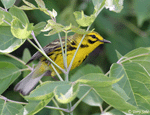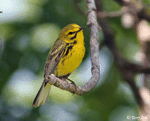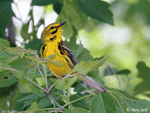| Length: 5 inches | Wingspan: 7.5 inches | Seasonality: Rare visitor |
| ID Keys: Plain olive upperparts, yellow on chest with dark streaks on sides, 2 white wingbars. | ||
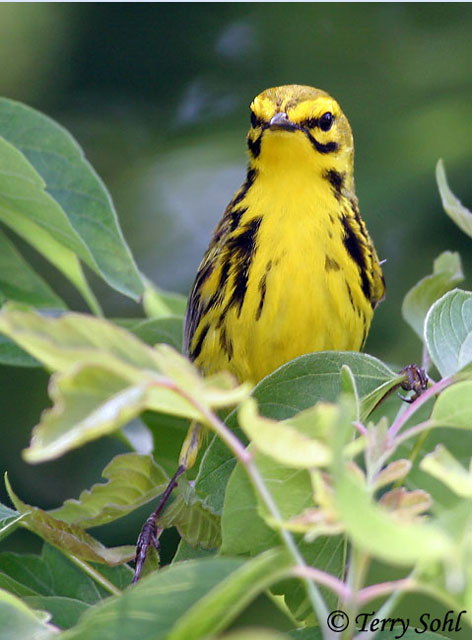 The Prairie Warbler is poorly named, as they are primarily found
in shrubby dense thickets. Much of their preferred habitat is a result of
forest disturbance or the abandonment of farm fields. As these areas
eventually progress to a mature forest again, they are forced to find new areas
of disturbance to colonize.
The Prairie Warbler is poorly named, as they are primarily found
in shrubby dense thickets. Much of their preferred habitat is a result of
forest disturbance or the abandonment of farm fields. As these areas
eventually progress to a mature forest again, they are forced to find new areas
of disturbance to colonize.
Habitat: Prefers brushy habitat and thickets, such as second growth forest, forest edges, shrubby forest undergrowth, and brushy fields. Can also be found in mangrove swamps in Florida.
Diet: Primarily feeds on insects. Will also occasionally take berries or sap from sapsucker wells.
Behavior: Forages by moving through the foliage, gleaning insects from leaves and branches. Will also glean insects from plants while hovering, or fly out to capture flying insects in mid-air.
Breeding: Non-breeder in South Dakota
Song: A thin rising zee-zee-zee-zee-zee-zee. Click here to listen to the Prairie Warbler's song.
Migration: Summers throughout much of the eastern United States, except in the upper Midwest/Great Lakes region, and northern New England. Winters in Florida and the Caribbean, with some Florida birds being permanent residents.
Interactive eBird Map: Click here to access an interactive eBird map of Prairie Warbler sightings
Similar Species: Palm Warbler, Yellow Warbler, Cape May Warbler
Conservation Status: Numbers appear to have declined in recent decades, possibly due to habitat changes. However, they are still found over a wide geographic region, and are common in some areas. The IUCN lists the Prairie Warbler as a species of "Least Concern".
Further Information: 1) USGS Patuxent Bird Identification InfoCenter, Prairie Warbler
3) Audubon Guide - Prairie Warbler
Special Note: The photo on this page, and all the photos accessed through the image chips or links below, are of a very misplaced Prairie Warbler who was found by a group of birders at Newton Hills State Park in Lincoln County, Spring 2007. Despite the nearest normal breeding range being found in Missouri, this bird was singing furiously along Sergeant Creek in the Park. It had obviously established territory, singing repeatedly from a series of perches. It was postulated that the bird may be courting female Yellow Warblers. This male Prairie Warbler was found constantly chasing male Yellow Warblers in the area. In June, I found this male Prairie Warbler gathering caterpillars, with several in his mouth at once, as if feeding young.
Photo Information: June 5th, 2007 - Newton Hills State Park, South Dakota - Terry Sohl
Additional Photos: Click on the image chips or text links below for additional, higher-resolution Prairie Warbler photos.
| Click on the map below for a higher-resolution view |
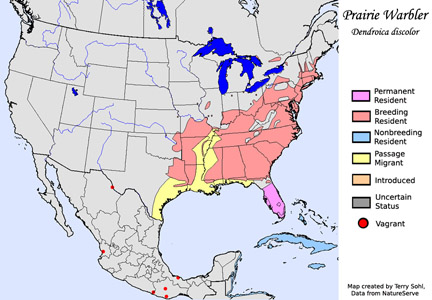 |
| South Dakota Status: Very rare visitor, with only a handful of records in the state. |
Additional Prairie Warbler Photos
Click for a higher-resolution version of these photos
